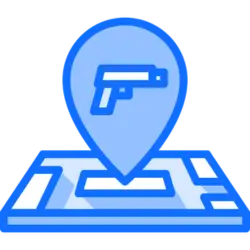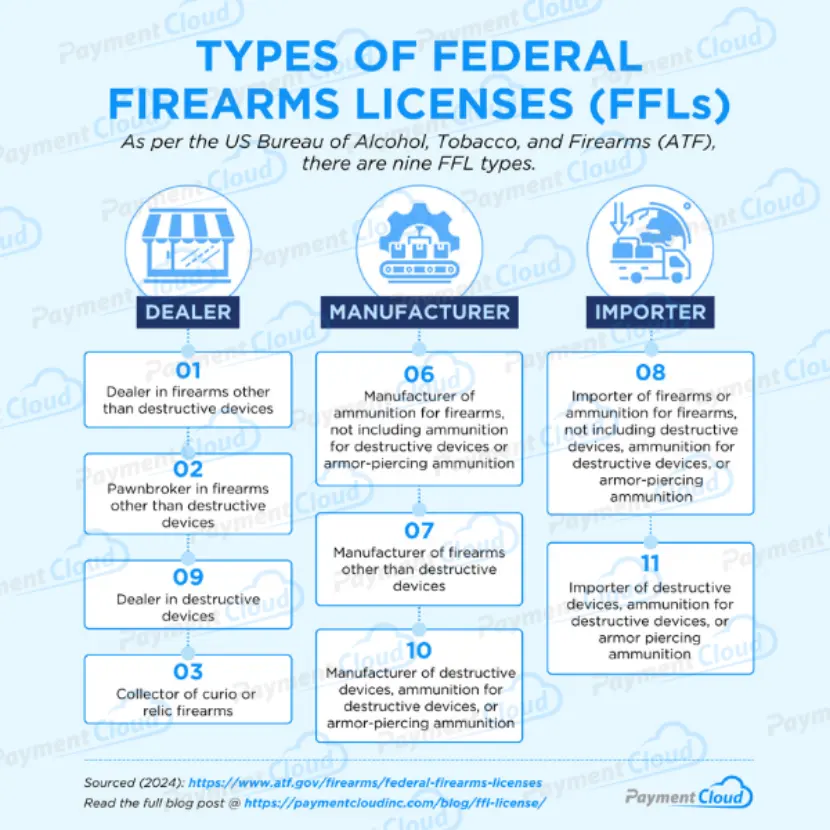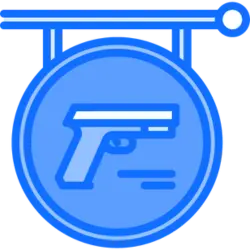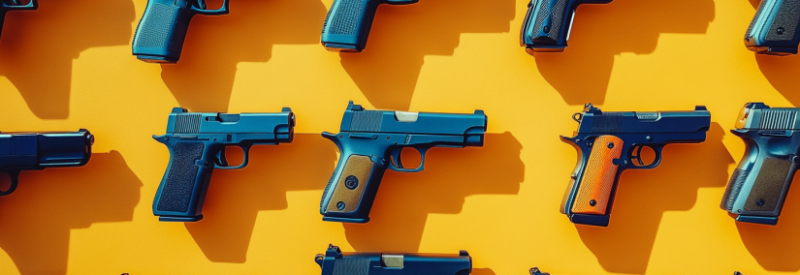
If you’re interested in entering the firearms business, you’ll need an FFL. A federal firearms license is required to sell, manufacture, or import firearms.
The ATF (Bureau of Alcohol, Tobacco, Firearms, and Explosives) issues nine different types of licenses, ranging from simple collector’s licenses to more expensive licenses that allow the importation of firearms and destructive devices. The initial license application for each type is much the same, but there are additional fees and post-application steps to consider.
In this guide, we’ll help you determine the best license type for your business and walk you through the steps on how to get an FFL.
What Is a Federal Firearms License (FFL)?
A federal firearms license establishes what type of firearms business you are legally allowed to operate, from firearm manufacturing to an FFL transfer to facilitate the trade of a gun between two parties.
FFLs are issued and controlled by the ATF. An FFL has to be renewed every few years, and a business that possesses an FFL will need to maintain certain safety and documentation standards. Otherwise, the FFL could be revoked.
What Are the FFL License Types?
There are nine types of federal firearms licenses ranging from Type 1 to Type 11. Understand what each type covers to choose the right license for your business.
FFL Type 01 – Dealer in Firearms (non-destructive only)
This type of FFL license allows you to sell and repair firearms and covers a limited ability to import ammunition and guns. This license is the most common option for gunsmiths and those wanting to establish a storefront.
FFL Type 02 – Pawnbroker (non-destructive only)
Pawnshop owners who want to lend money secured by a firearm will need this special type of license. This license also allows the holder to repair and sell firearms.
FFL Type 03 – Collector of Curios and Relics
This specialized license is designed for those interested in collecting older firearms. The license lets you buy, sell, and trade firearms that qualify as curios and relics [1]ATF eRegulations. “27 CFR Part 478.” Accessed April 2, 2025. . This also includes the legal ability to engage in buying, selling, and transporting across state lines without the need to utilize a dealer’s services. This license does not allow you to operate a firearms business.
FFL Type 06 – Manufacturer of Ammunition (non-destructive only)
Those who intend to manufacture ammunition for sale or distribution need this license. A type 06 license does not allow for the manufacturing of armor-piercing rounds or ammunition for destructive devices.
FFL Type 07 – Manufacturer of Firearms (non-destructive only)
Manufacturers looking to produce firearms for sale require this type of license. This license also allows the manufacturers to buy and sell guns as well as manufacture ammunition. A manufacturer of National Firearms Act (NFA) firearms (such as machine guns or short-barreled rifles) will also need to become a special occupational taxpayer (SOT). [2]ATF. “When must firearms special (occupational) taxes be paid and how much are the taxes?” Accessed April 2, 2025.
FFL Type 08 – Importer or Firearms and Ammunition (non-destructive only)
This type of license is for a business looking to import firearms and/or ammunition. The license also allows the holder to sell imported firearms and ammunition.
FFL Type 09 – Dealer in Destructive Devices
This specialized license allows a business to sell firearms considered destructive devices, such as machine guns and silencers. You can also sell ammunition for destructive devices with this license.
FFL Type 10 – Manufacturer of Destructive Devices
Manufacturers producing firearms considered destructive devices or ammunition for this type of weapon will need this special license. This license also allows for the selling of destructive devices as well as occasional importing.
FFL Type 11 – Importer of Destructive Devices
For a business looking to import any firearm, ammunition, or device considered a destructive device, this type of license is necessary. You can also sell firearms and ammunition with this license.

How Much Does an FFL Cost?
The cost to obtain an FFL license depends on the type you acquire. The below section outlines the initial application fee and three-year renewal fee:
| FFL Type | Application Cost | Renewal Fee |
| Type 01 | $200 | $90 |
| Type 02 | $200 | $90 |
| Type 03 | $30 | $30 |
| Type 06 | $30 | $30 |
| Type 07 | $150 | $150 |
| Type 08 | $150 | $150 |
| Type 09 | $3,000 | $3,000 |
| Type 10 | $3,000 | $3,000 |
| Type 11 | $3,000 | $3,000 |

FFL cost per year
The FFL you obtain is good for 3 years, so the fee should be considered over a three-year period. For example, if you obtain a Type 01 FFL for $200, the yearly cost would be $67. At renewal, you’ll only pay $90 for the same license, giving you a yearly cost of $30.

Fingerprinting
To obtain an FFL, you must supply your fingerprints with the application. However, there’s no requirement that fingerprinting must be done by law enforcement or other government professionals. That said, you can buy your own kit to take your fingerprints for the form. The cost typically ranges between $20-$50 per card. [3]Certifix Livescan. “How much does it cost to get my Live Scan or ink fingerprint card processed?” Accessed April 2, 2025.

FBI check
The FBI does not charge a fee for NCIS checks. However, states acting as points of contact may charge a fee. The background check itself only takes about 30 seconds.

Required training courses
In 1999, the ATF implemented the National Firearms Examiner Academy (NFEA), which is currently the only national training program that provides a standardized curriculum in the firearm field.

Additional costs
There are various additional costs you may encounter when obtaining an FFL. One of which is an ITAR/DDTC registration. If you meet the State Department’s definition of a gun manufacturer and manufacture products listed in the USML, you must register with the Directorate of Defense Trade Controls (DDTC) at a cost of $2,250 every year.
Another sneaky cost is excise tax payments. Manufacturers that make more than 50 firearms in one year are charged a 10 to 11 percent tax on the firearm’s value. To make such a steep tax worth it, manufacturers tend to stop yearly production at 49 firearms or produce in excess of 50 that the tax is worth it.
How to Get an FFL
The basic application process for an FFL is the same for all types of licenses. Here are the general steps you’ll need to take.
Step 1: Determine eligibility – who is eligible for an FFL license?
The first step is to determine whether you are permitted to hold an FFL. To be eligible, you’ll have to meet these qualifications set forth in the Gun Control Act of 1968:[4]ATF. “Gun Control Act.” Accessed April 2, 2025.
- Be at least 21 years old
- Be a citizen/ legal permanent resident of the United States
- Have no felony convictions
- Have no history of illegal drug use (this includes federally-illegal marijuana)
- Have no domestic violence convictions
- Have no other convictions disqualifying you from owning a gun
- Have no formal diagnosis as mentally incompetent
- Have no violations of any federal gun laws
- Operate out of a physical location
Additionally, you’ll have to certify that:
- State or local law does not prohibit the business conducted under your license
- Within 30 days of approval, the business is compliant with state and local law, and no transactions are made until these requirements are met.
- You’ve notified the chief law enforcement officer of your intention to apply for an FFL
- You have safe and secure gun storage and safety devices available where your firearms are sold.
Applicants failing to meet the above criteria may not be eligible for an FFL. However, they may be able to sell items at gun shows without a license.
Step 2: Review FFL requirements – federal & state
If you’re 21 or older and can legally purchase a firearm, you likely meet the criteria by the ATF (listed above) to be eligible for an FFL license. Still, it’s important to double-check to be sure you qualify.
Certain groups of people cannot possess firearms or ammunition. As such, they aren’t eligible for an FFL license. These are “prohibited persons” by the ATF, including anyone who is or has been:
- A person with a felony conviction
- A fugitive
- An undocumented immigrant
- Diagnosed as mentally incompetent
- Committed to a mental institution
- Under indictment or found guilty of a crime punishable by more than a year in prison
- Found guilty of a domestic violence crime
- Under a court order restraining you from making threats against, stalking, or harassing an intimate partner or their child
- An unlawful user of any controlled substance
- Received a dishonorable military discharge
- Relieved of U.S. rights to citizenship
Review your state’s FFL requirements
You’ll also want to review any state-level requirements to ensure you’re in compliance before applying for your FFL. Each state may have separate rules and regulations regarding the operation of a firearms-related business. This can include set zoning restrictions, additional license requirements, the need for specialized permits, and the proper business registration.
| Alabama | Hawaii | Massachusetts | New Mexico | South Dakota |
| Alaska | Idaho | Michigan | New York | Tennessee |
| Arizona | Illinois | Minnesota | North Carolina | Texas |
| Arkansas | Indiana | Mississippi | North Dakota | Utah |
| California | Iowa | Missouri | Ohio | Vermont |
| Colorado | Kansas | Montana | Oklahoma | Virginia |
| Connecticut | Kentucky | Nebraska | Oregon | Washington |
| Delaware | Louisiana | Nevada | Pennsylvania | West Virginia |
| Florida | Maine | New Hampshire | Rhode Island | Wisconsin |
| Georgia | Maryland | New Jersey | South Carolina | Wyoming |
If you don’t meet your state’s requirement for owning and operating a firearm business, the state can stall your FFL application or refuse to let you open your business until you comply with their regulations.
Step 3: Decide on the FFL type – what type of FFL do you need?
As of 2023, there were 132,383 active FFLs. [5]ATF “Fact Sheet – Facts and Figures for Fiscal Year 2023” Accessed April 2, 2025. The most common non-collectors license was Type 01, with 50,309 active holders. Compare that to the 147 FFLs issued for Dealers of Destructive Devices.
While Type 01 is the most common, that doesn’t mean it’s the right one for your business. Which type of license you’ll need depends on what your main business model will be. There are four main categories of FFLs:
- Collectors – buy and sell for personal use
- Dealers – sell firearms
- Manufacturers – make firearms and ammunition
- Importers – import firearms and ammunition
Once you’ve narrowed down the license options to the type of firearms business you will be engaging in, you need to consider whether you want to handle NFA firearms or destructive devices.[6]ATF “Which firearms are regulated under the NFA?” Accessed April 2, 2025. For instance, a Type 01 works for most sellers, but if you want to sell machine guns, you’ll need a Type 09 license.

Is an FFL really necessary?
To legally participate in a firearms business, you need an FFL. To retain your FFL, you can only engage in activities covered by the type of FFL you obtained.
If you are found to be engaging in a firearms business without the appropriate license, you could be hit with severe penalties, including the revocation of your FFL, hefty fines, and serious jail time. [7]Leppard Law “Can You Be Federally Charged for Selling Guns Without a License?” Accessed April 2, 2025.
You may not need an FFL for these exceptions:
- Selling a personal firearm (i.e., selling your own gun to a dealer or another individual)
- Selling ammunition only
- Family transfers (depending on state)
- Selling certain antique firearms

Take an online course
Navigating the world of FFL types and license requirements can get confusing. If you need a little assistance, consider taking an online course. There are currently only a few online certified FFL courses available. When looking into choosing an FFL course, you want to make sure you are receiving:
- Advice from a licensed firearms attorney with the necessary qualifications
- Guidance from an industry professional who knows the ins and outs of the ATF and the firearms industry at large
- Software that helps you track course progress
- Automatic notifications of updates to applicable firearms laws
- Compliance training necessary for both you and your employees
For the ultimate FFL course, including a start-up course, sample forms, and step-by-step instructions, we recommend RocketFFL.
Step 4: Fill out the required ATF form and gather supporting documents
The next step is to fill out your application. You can download the 7/7CR form and fill in your information. You must include a photo and fingerprint card with your application. You must fill out applications for yourself and anyone you intend to designate as a Responsible Person under your FFL.
If you intend to operate your business out of more than one location or storefront, you must complete separate applications for each location.
Step 5: Apply for your FFL – submit an application with the appropriate fee
After you’ve filled out your application and gathered all supporting documents, submit your application along with the payment for your FFL type. You’ll also need to send a copy of the completed application to your local Chief Law Enforcement Officer.
Step 6: Undergo a Federal Firearms Licensing Center (FFLC) background check
Once the Federal Firearms Licensing Center (FFLC) receives your completed application, they will review your materials and perform a background check. After completing the background check, the FFLC will send your application to your local ATF field office.
Step 7: Complete an in-person interview with an Industry Operations Investigator (IOI)
The next step is an interview with an Industry Operations Investigator (IOI) from the ATF.[8]ATF. “Apply for a License.” Accessed April 2, 2025. The interviewer will ask you about your business as well as your knowledge of firearm regulations. They’ll also inspect your place of operations to ensure you’re starting a legitimate business.
Essentially, you have to demonstrate to your IOI your level of commitment.
Step 8: Wait for FFLC to issue your license
The FFLC will sign off on and approve your interview and application and then issue you your new federal firearms license.
Your FFL Application Has Been Approved — What’s Next?
Once you have your FFL, you can move on to the next steps in opening your firearms business.

Set up payment processing
If you haven’t done so already, secure a gun-friendly merchant services provider. This way, you can begin processing payments for firearms sales with your new FFL.
As a business involved with firearms and ammunition, you will need a high-risk merchant account. With help from a specialized payment processor, you can launch your business knowing you have a solid payment services provider knowledgeable in the highly regulated firearms industry.
The sooner you find a reputable high-risk payment processing partner, the sooner you can start turning a profit with your firearms business.

SOT registration
Depending on the type of firearms business you have started, you may need to register as an SOT. If you intend to import, manufacture, or sell NFAs, you’ll need to pay a special tax. Instead of paying per item, you can register as a class 1, 2, or 3 SOT and pay a set amount per year. NFA firearms can include suppressors, full-auto machine guns, and other items classified as destructive devices.
Registration costs between $500 and $1,000, depending on the size of your business, and runs from July through June each year. Alternatively, you can opt not to register and instead pay a $200 transfer tax for each item. However, this only makes financial sense if you are transacting on NFAs on an infrequent basis.

Check for additional registration and permits
You may be required to register your business with certain government agencies or obtain special permits or licenses for select activities. What you will need to do depends on your business location, business type (import, sell, or manufacture), the types of firearms you’re selling, and the services you provide.
For instance, manufacturers and many gunsmiths need to register with the Directorate of Defense Trade Controls (DDTC). And the majority of importers need to apply for an import permit from the ATF.
Additional licenses and permits may be required on a local or state-level basis.

Get insurance

Before you open your firearms business, you’ll need to get the appropriate type of insurance. As a firearms manufacturer, seller, or importer, your insurance needs will likely be higher and more expensive than the average business.
Research insurance providers, insurance requirements, and recommended insurance amounts. In most cases, taking out the appropriate insurance policies for your business is a legal requirement. Without insurance, you won’t be able to open your business.

Stay organized and maintain accurate records
The ATF can and will revoke your FFL if you fail an inspection. This is why it is so important to maintain accurate records and ensure you are in compliance with all ATF safety regulations at all times. Surprise ATF inspections are common and can occur as frequently as once a year, so it’s vital for you to stay organized and compliant from day one.
If your FFL gets revoked, you can reapply for a new one, but your chances of getting approval again will be slim.
Final Thoughts
The steps required in applying for and obtaining an FFL are straightforward, and you can be approved in under 60 days. However, it’s important to remember that getting your FFL is just one element in setting up your firearms business. You may also need to apply for additional permits, find a gun-friendly payment services provider, and obtain insurance.
The firearms industry is booming, and the future looks equally promising. If you’re prepared and committed, now is an excellent time to complete your FFL application and launch your business.
Federal Firearms License FAQs
How long does it take to obtain an FFL?
Generally, it takes two months to issue your FFL license from the time the ATF receives your application.
How long is an FFL valid?
An FFL is valid for three years from the date it was issued.
Can I get an FFL without a business?
An FFL is only meant for business use. The only exception is a Type 03 FFL. This collector’s FFL does not require you to own or operate a business.
Can I get a home-based FFL?
Yes, you can get an FFL that’s based out of your home. However, local zoning laws and restrictions may prevent you from applying for a home-based FFL.
Can I carry a concealed weapon with an FFL?
No. To carry a concealed weapon, you need a separate Carrying a Concealed Weapon (CCW) permit that’s valid in your state.
What does a valid FFL number look like?
A valid FFL number consists of a total of 14 numbers and one letter. For example: 1-99-889-77-6Y-55555.
This FFL number is divided into six sections, each containing information about the specific FFL. The first section denotes in which region of the United States the FFL was issued. The second indicates the IRS district where the FFL is located. The third is mainly for federal purposes.
The fourth section is the most important for a license holder. It tells you the type of FFL you have, which affects what kinds of activity you’re permitted to do.
The fifth section marks the month and year when the FFL expires. Finally, the sixth section is a code that’s unique to you and your FFL.





